Planning a trip to Norway? You’re probably wondering about the Norway Tourism Cost. SIXT.VN is here to break down the expenses and offer savvy strategies to make your dream Norwegian adventure a reality without breaking the bank. We will provide solutions to help you optimize your travel budget, ensuring an unforgettable trip filled with scenic fjords and vibrant cultural experiences, all while keeping costs manageable through strategic planning and smart choices.
1. Understanding Norway Tourism Cost: An Overview
Is Norway an expensive destination?
Yes, Norway is generally considered an expensive country for tourists. However, with careful planning and budgeting, it’s possible to experience the beauty of Norway without overspending. The Norway tourism cost can be influenced by factors like accommodation, transportation, food, and activities. Therefore, understanding these elements is key to managing your budget effectively.
1.1 Factors Influencing Norway Tourism Cost
What factors impact the cost of a trip to Norway?
Several factors influence the overall cost of Norway tourism, including the time of year, choice of accommodation, mode of transportation, dining preferences, and activities undertaken. Peak season travel, luxury accommodations, and dining out frequently will increase costs significantly. Traveling during the off-season and opting for self-catering and public transport can substantially lower expenses.
- Seasonality: Summer (June-August) is the peak tourist season, leading to higher prices for flights, accommodation, and tours. Traveling during the shoulder seasons (May and September) can offer a balance of good weather and lower prices.
- Accommodation Type: Hotels are generally more expensive than hostels, guesthouses, or Airbnb options.
- Transportation: Domestic flights and rental cars are pricier than trains and buses.
- Dining Habits: Eating out at restaurants is expensive. Self-catering can save a lot of money.
- Activities: Tours and excursions add to the overall cost, but there are many free or low-cost activities available, such as hiking and exploring national parks.
1.2 Average Daily Cost for Tourists in Norway
How much should you budget per day for a Norway trip?
The average daily cost for tourists in Norway can range from $150 to $400 USD per person, depending on travel style. Budget travelers can manage on around $150-$200 USD per day by staying in hostels, cooking their own meals, and using public transport. Mid-range travelers should budget $250-$350 USD per day for comfortable hotels, some restaurant meals, and a mix of public transport and occasional tours. Luxury travelers can expect to spend $400+ USD per day for high-end hotels, fine dining, and private tours.
| Traveler Type | Accommodation | Food | Transportation | Activities | Daily Budget (USD) |
|---|---|---|---|---|---|
| Budget | Hostel/Airbnb | Self-Catering | Public Transport | Free/Low-Cost | $150 – $200 |
| Mid-Range | Comfortable Hotel | Mix of Dining Out | Public Transport & Car | Some Paid Tours | $250 – $350 |
| Luxury | High-End Hotel/Resort | Fine Dining | Private Transport | Exclusive Tours | $400+ |
2. Accommodation Costs in Norway: Smart Choices
What are the accommodation options and their average costs in Norway?
Accommodation in Norway can be a significant expense, but there are various options to suit different budgets. Hotels, hostels, guesthouses, and Airbnb rentals are all available.
- Hotels: Expect to pay $150-$300+ USD per night for a standard double room in a 3-4 star hotel.
- Hostels: Dorm beds typically cost $30-$50 USD per night.
- Guesthouses/Bed & Breakfasts: Prices range from $100-$200 USD per night.
- Airbnb: Renting an apartment or house can be a cost-effective option, especially for families or groups. Prices vary widely depending on location and amenities, but expect to pay $100-$250+ USD per night.
- Camping: Norway has many beautiful campsites, with prices ranging from $20-$40 USD per night.
- Cabins and Cottages: Renting a cabin or cottage can be a great option for a more rustic experience. Prices vary, but expect to pay $80-$200+ USD per night.
According to research from Innovation Norway in 2023, staying in alternative accommodations like cabins or guesthouses can reduce accommodation costs by up to 30% compared to hotels, providing significant savings.
2.1 Tips for Saving on Accommodation
How can you reduce accommodation expenses in Norway?
- Travel in the Off-Season: Accommodation prices are lower outside of the peak summer months.
- Book in Advance: Booking well in advance can secure better rates.
- Consider Hostels: Hostels are a budget-friendly option, especially for solo travelers.
- Look for Deals and Discounts: Check booking websites for deals and discounts.
- Stay Outside City Centers: Accommodation is often cheaper in smaller towns and rural areas.
- Use Loyalty Programs: If you’re a member of a hotel loyalty program, use your points to save money.
- Consider Camping: Camping is a very affordable way to experience Norway’s natural beauty.
2.2 Recommended Accommodation Options
Where are the best places to stay in Norway on a budget?
Some recommended budget-friendly accommodation options include:
- Oslo: Anker Hostel, Saga Apartments Oslo
- Bergen: Marken Guesthouse, Bergen Hostel Montana
- Stavanger: Stavanger Bed & Breakfast, Skansen Hostel
- Flåm: Flåm Marina & Apartments, Brekke Gard Apartments
SIXT.VN offers a range of options for accommodation bookings, from budget-friendly hostels to comfortable apartments, ensuring that you find the perfect stay that fits your budget and preferences. Check out our website for exclusive deals and discounts on accommodation in Norway.
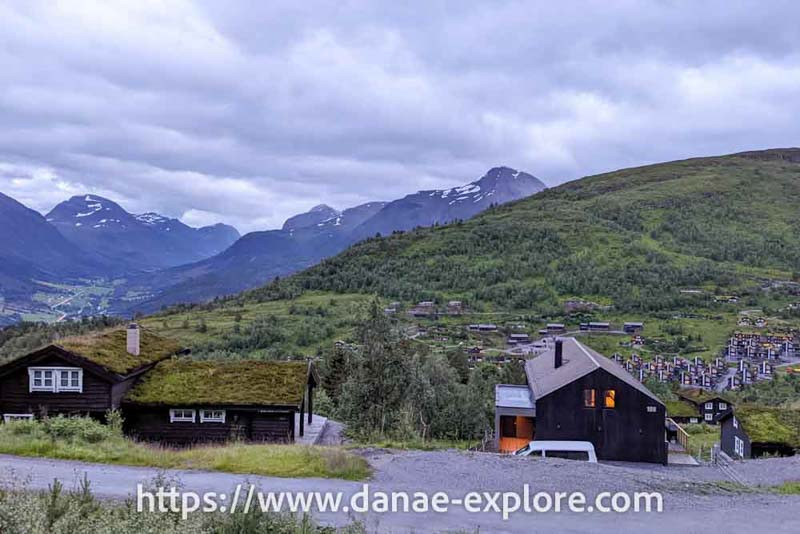 Dark wooden houses, with landscaped roofs, in a valley with green vegetation and mountains with a little snow in the background. Norway, is it expensive to travel in Norway?
Dark wooden houses, with landscaped roofs, in a valley with green vegetation and mountains with a little snow in the background. Norway, is it expensive to travel in Norway?
3. Food and Dining Costs: Eating Smart
What are the average food and dining costs in Norway?
Food and dining can be a substantial part of the Norway tourism cost. Eating out at restaurants is generally expensive, but there are ways to reduce these costs.
- Restaurants: A meal at an average restaurant can cost $30-$50 USD per person. Fine dining can easily exceed $80 USD per person.
- Cafes: A coffee and a pastry will cost around $10-$15 USD.
- Groceries: Buying groceries and cooking your own meals is much cheaper. Expect to pay around $50-$70 USD per week for groceries per person.
- Fast Food: A fast food meal costs around $15-$20 USD.
3.1 Saving Money on Food
How can you eat well without overspending in Norway?
- Cook Your Own Meals: Make use of kitchen facilities in your accommodation and prepare your own meals.
- Shop at Local Supermarkets: Buy groceries at supermarkets like REMA 1000, Kiwi, or Coop for the best prices.
- Pack Snacks: Bring snacks with you to avoid buying expensive snacks while you’re out and about.
- Eat Lunch Instead of Dinner: Lunch menus are often cheaper than dinner menus at restaurants.
- Look for “Dagens Rett”: Many restaurants offer a “dagens rett” (dish of the day) at a lower price.
- Visit Local Markets: Explore local markets for fresh produce and local specialties at reasonable prices.
3.2 Grocery Shopping Tips
What should you buy at grocery stores to save money in Norway?
- Basic Staples: Stock up on pasta, rice, bread, eggs, and canned goods.
- Local Produce: Buy seasonal fruits and vegetables for better prices.
- Dairy Products: Milk, cheese, and yogurt are relatively affordable.
- Snacks: Purchase snacks like granola bars, nuts, and dried fruit.
- Drinks: Buy water and juice at supermarkets instead of convenience stores.
Norway’s local cuisine is not always budget-friendly, making self-catering a practical choice. According to a 2022 report by the Norwegian Food Research Institute, self-catering can save travelers up to 40% on food costs compared to dining out regularly.
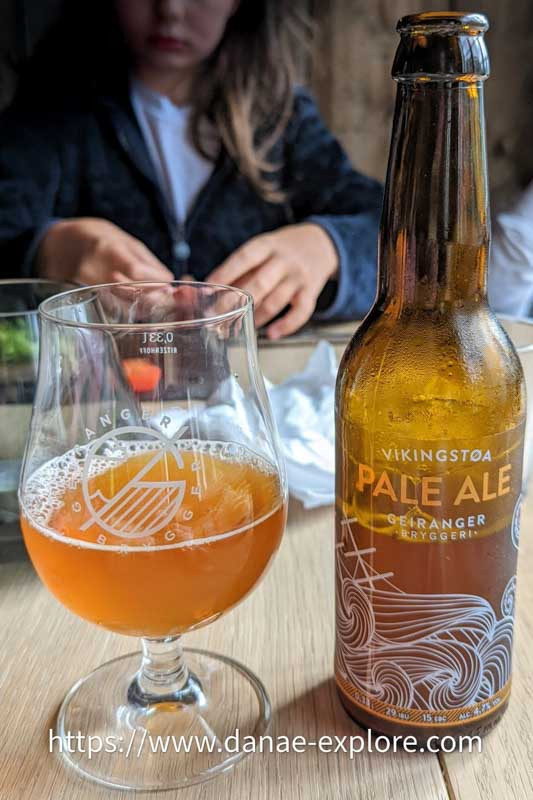 Glass and bottle of Geiranger beer, in restaurant in Geiranger Fjord, Norway.
Glass and bottle of Geiranger beer, in restaurant in Geiranger Fjord, Norway.
4. Transportation Costs: Getting Around Norway Economically
What are the best ways to travel around Norway on a budget?
Transportation costs can add up quickly in Norway. However, there are several options for getting around the country without breaking the bank.
- Public Transport: Norway has an efficient public transport system, including trains, buses, and ferries. Prices vary depending on the distance and route, but a single bus ticket in a city costs around $4-$6 USD.
- Rental Cars: Renting a car gives you flexibility but can be expensive. Expect to pay $80-$150+ USD per day for a compact car, plus the cost of gasoline and tolls.
- Domestic Flights: Domestic flights are convenient for long distances but can be pricey. Prices vary depending on the route and time of year.
- Bicycles: Renting a bicycle is a great way to explore cities and scenic areas. Prices range from $20-$40 USD per day.
4.1 Public Transport vs. Rental Car
Which is more cost-effective: public transport or a rental car?
Public transport is generally more cost-effective than renting a car, especially for solo travelers or couples. However, a rental car offers more flexibility and can be a better option for families or groups, particularly if you plan to explore remote areas.
- Public Transport:
- Pros: Cheaper, no need to worry about parking or tolls, environmentally friendly.
- Cons: Less flexible, can be time-consuming, limited access to remote areas.
- Rental Car:
- Pros: More flexible, convenient for exploring remote areas, good for families or groups.
- Cons: More expensive, need to pay for parking and tolls, can be stressful to drive in cities.
4.2 Saving Money on Transportation
How can you reduce transportation costs in Norway?
- Book in Advance: Book train and bus tickets in advance to get cheaper fares.
- Consider a Travel Pass: A travel pass can be a cost-effective option if you plan to use public transport frequently.
- Use Public Transport in Cities: Avoid renting a car in cities like Oslo and Bergen. Use public transport instead.
- Carpool: If you’re traveling with a group, consider carpooling to save on rental car costs.
- Take Advantage of Free Transportation: Some cities offer free transportation on certain days or during special events.
- Walk or Bike: Walking and biking are great ways to explore cities and scenic areas for free.
SIXT.VN offers convenient and affordable car rental options across Norway, but we also provide information and booking assistance for public transportation, ensuring you can choose the most economical and efficient way to travel.
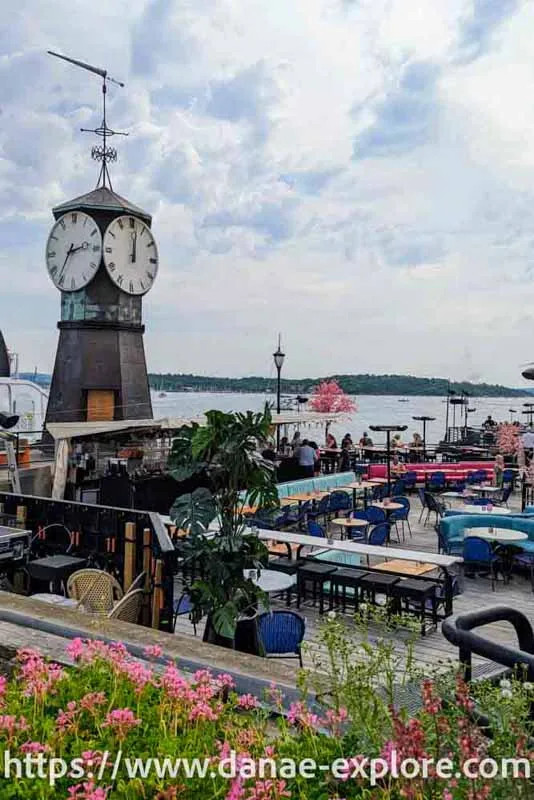 Cafés by the fjord in Oslo. A tower with a clock is visible.
Cafés by the fjord in Oslo. A tower with a clock is visible.
5. Activities and Attractions: Free and Affordable Options
What are the best free and low-cost activities in Norway?
Norway is renowned for its natural beauty, and many of the best activities are free or low-cost.
- Hiking: Norway has countless hiking trails, ranging from easy walks to challenging treks.
- Exploring National Parks: Norway has several national parks with stunning landscapes and diverse wildlife. Entrance is typically free.
- Visiting Fjords: The Norwegian fjords are a must-see. You can admire them from viewpoints or take a boat trip.
- Exploring Cities: Cities like Oslo, Bergen, and Stavanger have many free attractions, such as parks, museums, and historical sites.
- Enjoying Nature: Norway’s nature is free to enjoy. You can swim in lakes, fish in rivers, and pick berries and mushrooms in forests (with some restrictions).
5.1 Free Activities in Norway
What can you do in Norway without spending money?
- Hike to Pulpit Rock (Preikestolen): The hike itself is free; you only need to pay for transportation to the trailhead.
- Visit Vigeland Sculpture Park in Oslo: This park features over 200 sculptures by Gustav Vigeland and is free to enter.
- Explore Bryggen in Bergen: Wander through the historic wharf district of Bryggen, a UNESCO World Heritage Site.
- Visit Akershus Fortress in Oslo: Explore the medieval fortress and enjoy views of the Oslofjord.
- Hike in Jotunheimen National Park: Enjoy breathtaking mountain scenery and hiking trails.
5.2 Paid Activities Worth the Cost
Which paid activities are worth the investment in Norway?
- Fjord Cruises: A fjord cruise is a classic Norwegian experience and well worth the cost.
- Flåm Railway: This scenic train journey takes you through stunning landscapes.
- Kayak Tours: Explore the fjords and coastline by kayak.
- Glacier Walks: Experience the thrill of walking on a glacier with a guided tour.
- Northern Lights Tours: If you’re visiting in winter, a Northern Lights tour is a must.
When planning activities, consider purchasing city cards like the Oslo Pass or Bergen Card, which offer free entry to many attractions and free public transport. According to Visit Norway, these cards can save tourists up to 50% on activity costs.
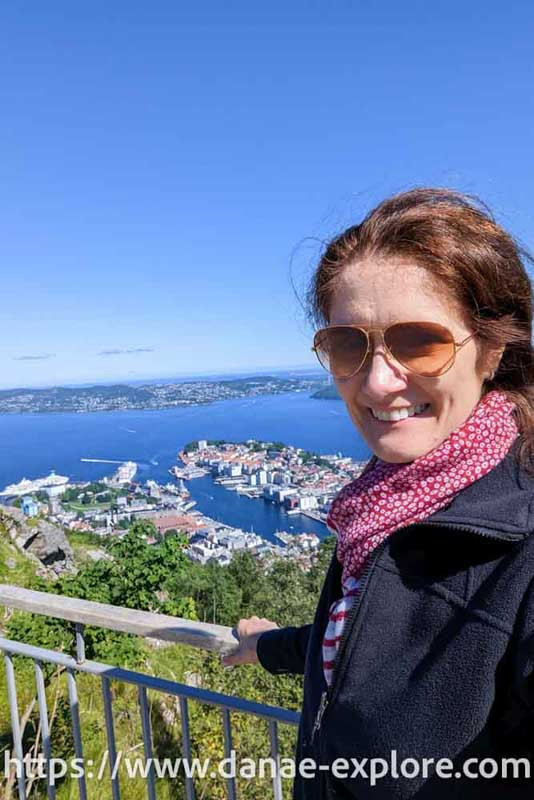 Bergen, view from the funicular. Caucasian girl with sunglasses, red scarf and black blouse looking at camera
Bergen, view from the funicular. Caucasian girl with sunglasses, red scarf and black blouse looking at camera
6. Travel Insurance and Miscellaneous Costs
What other costs should you consider when planning a trip to Norway?
In addition to accommodation, food, transportation, and activities, there are several other costs to consider when planning a trip to Norway.
- Travel Insurance: Travel insurance is essential in case of illness, injury, or unexpected events.
- Visa Fees: Check if you need a visa to enter Norway.
- Currency Exchange Fees: Exchange currency before you travel to get the best rates.
- Souvenirs: Set aside a budget for souvenirs and gifts.
- Tips: Tipping is not mandatory in Norway, but it’s appreciated for good service.
- SIM Card: Consider buying a local SIM card for cheaper mobile data.
6.1 Importance of Travel Insurance
Why is travel insurance crucial for a trip to Norway?
Travel insurance is crucial for a trip to Norway because it protects you against unexpected events, such as:
- Medical Emergencies: Medical care can be expensive in Norway. Travel insurance covers medical expenses, hospitalization, and evacuation.
- Trip Cancellation or Interruption: If you have to cancel or interrupt your trip due to illness, injury, or other unforeseen circumstances, travel insurance can reimburse your expenses.
- Lost or Stolen Luggage: Travel insurance covers the cost of replacing lost or stolen luggage and personal belongings.
- Flight Delays or Cancellations: If your flight is delayed or canceled, travel insurance can cover the cost of accommodation, meals, and transportation.
SIXT.VN partners with reputable travel insurance providers to offer comprehensive coverage for your trip to Norway. Ensure peace of mind by securing travel insurance that fits your needs and budget.
6.2 Budgeting for Miscellaneous Expenses
How much should you set aside for unexpected costs in Norway?
It’s always a good idea to set aside a budget for unexpected costs when traveling. A general rule of thumb is to budget 10-15% of your total trip cost for miscellaneous expenses. This will cover things like:
- Unexpected transportation costs
- Medical expenses
- Souvenirs
- Tips
- Currency exchange fees
7. Saving on Airline Tickets to Norway
How can you find affordable flights to Norway?
Airline tickets are often the most significant expense of a trip. To save money on flights to Norway:
- Book in Advance: Airline tickets are usually cheaper when booked several months in advance.
- Be Flexible with Travel Dates: Flying on weekdays or during the off-season can save you money.
- Consider Alternative Airports: Flying into smaller airports near Norway can sometimes be cheaper.
- Use Flight Comparison Websites: Use flight comparison websites to find the best deals on flights.
- Sign Up for Email Alerts: Sign up for email alerts from airlines and travel websites to be notified of special deals.
- Use Frequent Flyer Miles: If you have frequent flyer miles, use them to book your flights to Norway.
7.1 Best Times to Book Flights
When is the optimal time to book flights to Norway for the best deals?
According to a study by Expedia, the best time to book flights for international travel is typically 2-3 months in advance. However, it’s always a good idea to start monitoring flight prices well in advance of your trip and be prepared to book when you see a good deal.
7.2 Airline Options and Tips
Which airlines offer affordable flights to Norway and how to find them?
Several airlines offer flights to Norway, including:
- Norwegian Air: A budget airline that offers direct flights from several cities in the US and Europe to Oslo.
- SAS (Scandinavian Airlines): The flag carrier of Norway, Sweden, and Denmark, offering flights from major cities worldwide.
- Lufthansa: A German airline that offers flights to Oslo and Bergen via Frankfurt or Munich.
- KLM: A Dutch airline that offers flights to Oslo and Bergen via Amsterdam.
- British Airways: Offers flights to Oslo and Bergen via London.
To find the best deals on flights, use flight comparison websites like Google Flights, Skyscanner, and Kayak. These websites allow you to compare prices from different airlines and travel agencies.
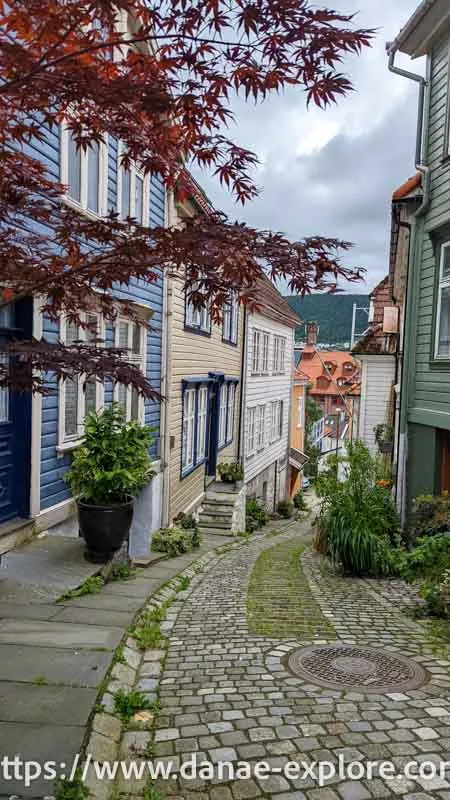 White wooden houses in Bryggen, Bergen, Norway
White wooden houses in Bryggen, Bergen, Norway
8. Mobile and Internet Costs: Staying Connected
How can you stay connected in Norway without high roaming charges?
Staying connected in Norway is essential for navigation, communication, and accessing information. However, roaming charges can be high. Here are some ways to stay connected without breaking the bank:
- Buy a Local SIM Card: Buying a local SIM card is the most cost-effective way to stay connected in Norway. You can buy a SIM card at Oslo Airport or in most cities.
- Use Free Wi-Fi: Many hotels, cafes, and public places offer free Wi-Fi.
- Rent a Mobile Hotspot: You can rent a mobile hotspot to create your own Wi-Fi network.
- Check with Your Mobile Provider: Check with your mobile provider about international roaming plans.
8.1 Local SIM Card Options
What are the best SIM card options for tourists in Norway?
Several mobile operators offer SIM cards for tourists in Norway, including:
- Telenor: Offers a range of prepaid SIM cards with different data allowances.
- Telia: Another major mobile operator in Norway, offering prepaid SIM cards with various data options.
- Ice: A smaller mobile operator that offers competitive prices on prepaid SIM cards.
SIXT.VN recommends checking with these providers for the latest deals and ensuring the SIM card you choose meets your data and calling needs.
8.2 Using Wi-Fi Effectively
Where can you find free Wi-Fi in Norway and how to use it safely?
Free Wi-Fi is available in many places in Norway, including:
- Hotels
- Cafes
- Restaurants
- Libraries
- Public Transportation Hubs
To use Wi-Fi safely:
- Use a VPN: A VPN encrypts your internet traffic and protects your personal information.
- Avoid Public Wi-Fi for Sensitive Transactions: Don’t use public Wi-Fi for online banking or other sensitive transactions.
- Make Sure the Network is Secure: Only connect to Wi-Fi networks that require a password.
- Turn Off File Sharing: Turn off file sharing to prevent others from accessing your files.
9. Cash vs. Card: Payment Options in Norway
Should you use cash or card in Norway?
Norway is a cashless society, and most businesses prefer card payments. While it’s a good idea to have some cash on hand for small purchases, you can use your credit or debit card for most transactions.
9.1 Card Usage in Norway
What types of cards are widely accepted in Norway?
Most major credit and debit cards are widely accepted in Norway, including:
- Visa
- Mastercard
- American Express
However, it’s always a good idea to check with your card issuer about international transaction fees.
9.2 Withdrawing Cash Economically
How can you minimize ATM fees when withdrawing cash in Norway?
To minimize ATM fees:
- Use ATMs from Major Banks: ATMs from major banks like DNB and Nordea typically have lower fees.
- Withdraw Larger Amounts: Withdraw larger amounts of cash to reduce the frequency of withdrawals.
- Check with Your Bank: Check with your bank about international ATM fees and consider using a card that doesn’t charge these fees.
- Use a Travel Credit Card: Some travel credit cards offer free ATM withdrawals.
SIXT.VN suggests informing your bank of your travel dates to avoid any holds on your account and researching the best card options for international travel.
10. Sample Itineraries and Budgets
What are some sample itineraries and budget breakdowns for different travel styles in Norway?
Here are some sample itineraries and budget breakdowns for different travel styles in Norway:
10.1 Budget Traveler (7 Days)
- Accommodation: Hostels or budget Airbnb ($350)
- Food: Self-catering ($210)
- Transportation: Public transport ($140)
- Activities: Free hiking, city exploration ($70)
- Miscellaneous: ($30)
- Total: $800
Sample Itinerary:
- Day 1: Arrive in Oslo, explore Vigeland Sculpture Park, visit Akershus Fortress.
- Day 2: Hike in Ekebergparken, visit the Oslo Opera House.
- Day 3: Take a train to Bergen, explore Bryggen.
- Day 4: Hike up Mount Fløyen, visit the Bergen Maritime Museum.
- Day 5: Take a bus to Stavanger, explore the city center.
- Day 6: Hike to Pulpit Rock (Preikestolen).
- Day 7: Depart from Stavanger.
10.2 Mid-Range Traveler (7 Days)
- Accommodation: Comfortable hotels or guesthouses ($700)
- Food: Mix of self-catering and restaurants ($420)
- Transportation: Mix of public transport and rental car ($420)
- Activities: Fjord cruise, Flåm Railway ($350)
- Miscellaneous: ($100)
- Total: $1990
Sample Itinerary:
- Day 1: Arrive in Oslo, visit the Viking Ship Museum, explore the city center.
- Day 2: Take a train to Flåm, experience the Flåm Railway.
- Day 3: Take a fjord cruise on the Nærøyfjord, hike in the area.
- Day 4: Rent a car, drive to Bergen, explore Bryggen.
- Day 5: Take the Fløibanen funicular to Mount Fløyen, visit the Bergen Aquarium.
- Day 6: Drive to Stavanger, hike to Pulpit Rock (Preikestolen).
- Day 7: Depart from Stavanger.
10.3 Luxury Traveler (7 Days)
- Accommodation: High-end hotels or resorts ($1400)
- Food: Fine dining ($700)
- Transportation: Private transport ($700)
- Activities: Exclusive tours, helicopter ride ($700)
- Miscellaneous: ($200)
- Total: $3700
Sample Itinerary:
- Day 1: Arrive in Oslo, stay at The Thief hotel, private tour of the city.
- Day 2: Visit the Munch Museum, enjoy a fine dining experience.
- Day 3: Fly to Bergen, stay at the Hotel Norge by Scandic, explore Bryggen.
- Day 4: Take a private fjord cruise, enjoy a helicopter ride over the fjords.
- Day 5: Visit the Troldhaugen Edvard Grieg Museum, enjoy a gourmet meal.
- Day 6: Fly to Stavanger, stay at the Clarion Hotel Stavanger, hike to Pulpit Rock (Preikestolen).
- Day 7: Depart from Stavanger.
These itineraries and budget breakdowns provide a starting point for planning your trip to Norway. Remember to adjust the costs based on your preferences and travel style.
FAQ about Norway Tourism Cost
1. Is Norway more expensive than other Scandinavian countries?
Yes, Norway is generally more expensive than other Scandinavian countries like Sweden and Denmark, primarily due to its higher cost of living and strong economy.
2. What is the cheapest time to visit Norway?
The cheapest time to visit Norway is during the shoulder seasons (May and September) or the winter months (November to March), excluding the Christmas and New Year periods.
3. Can I use US dollars in Norway?
No, US dollars are not widely accepted in Norway. The official currency is the Norwegian Krone (NOK).
4. How much does a cup of coffee cost in Norway?
A cup of coffee in Norway typically costs around $4-$6 USD.
5. Are credit cards widely accepted in Norway?
Yes, credit cards are widely accepted in Norway, especially Visa and Mastercard.
6. How much does it cost to rent a car in Norway?
The cost to rent a car in Norway ranges from $80 to $150+ USD per day, depending on the type of car and the rental company.
7. Is tipping customary in Norway?
Tipping is not customary in Norway, but it is appreciated for good service. A tip of 5-10% is generally acceptable.
8. How much does a domestic flight cost in Norway?
A domestic flight in Norway can cost anywhere from $50 to $200+ USD, depending on the route and time of year.
9. What are some free things to do in Oslo?
Some free things to do in Oslo include visiting Vigeland Sculpture Park, exploring Akershus Fortress, and hiking in Ekebergparken.
10. How can I save money on accommodation in Bergen?
To save money on accommodation in Bergen, consider staying in hostels, guesthouses, or Airbnb rentals, and book in advance.
Conclusion: Planning Your Affordable Norway Adventure
Planning a trip to Norway involves understanding the Norway tourism cost and making informed decisions to manage your budget effectively. By choosing affordable accommodation, self-catering, utilizing public transport, and taking advantage of free activities, you can experience the beauty of Norway without breaking the bank.
SIXT.VN is your reliable partner for planning an affordable Norway adventure. We offer a range of services to help you save money and enjoy a stress-free trip, including:
- Accommodation Bookings: Find the best deals on hotels, hostels, and Airbnb rentals.
- Transportation Options: Book rental cars or get information on public transport.
- Activity Recommendations: Discover free and low-cost activities to suit your interests.
- Travel Insurance: Secure comprehensive travel insurance for peace of mind.
Ready to explore Norway? Contact SIXT.VN today and let us help you plan your dream trip! Visit our website at SIXT.VN or call us at +84 986 244 358 for personalized assistance. Our address is 260 Cau Giay, Hanoi, Vietnam.
Don’t let high costs deter you from experiencing the breathtaking beauty of Norway. With careful planning and the right resources, your Norwegian adventure can be both unforgettable and affordable. Let SIXT.VN be your guide to making the most of your travel budget and creating lasting memories in this stunning destination.



